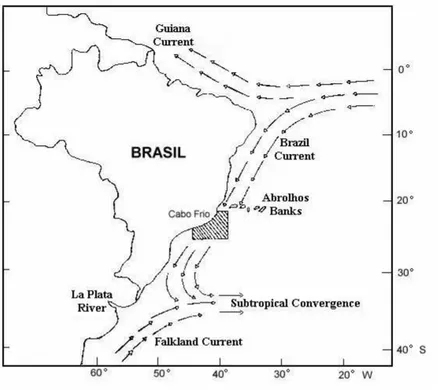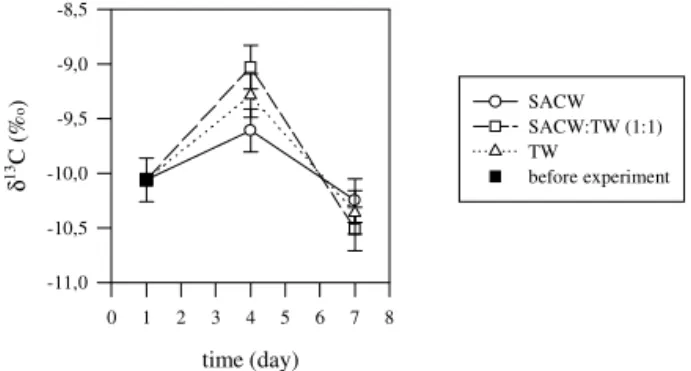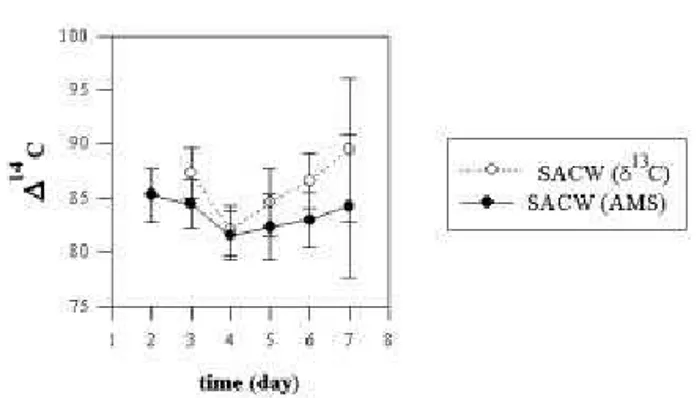Outeiro S˜ao Jo˜ao Batista, Valonguinho, Caixa Postal 100.644, 24.001-970, Niter ´oi, RJ, Brazil
2
Instituto de Estudos do Mar Almirante Paulo Moreira da Silva, Arraial do Cabo, RJ, Brazil
3
Department of Nuclear Physics, Australian National University, Canberra, Australia and Earth System Science, University of California, Irvine, CA 92697-3100, USA
4
Instituto de F´ısica, Universidade Federal Fluminense, Av. Litorˆanea s/n, Niter´oi, RJ, 24210-340, Brazil
Received on 6 September, 2003
We describe the use of the14C-AMS technique to study the influence of upwelling waters to the local biological production, at Arraial do Cabo, Brazil. Results on∆14
C from seaweed tissues incubated into three different types of water mass show the association of primary production with the upwelling waters. We also discuss the importance of high- precision14
C - AMS measurements for this kind of study, and the properly application of isotopic fractionation corrections on radiocarbon results.
1
The
14C - AMS technique and its
application on oceanographic
stud-ies
Radioactive14
C isotopes are produced in the upper regions of the atmosphere by the reaction14
N(n,p)14
C induced by neutrons yielded by spallation processes resulting from the interaction of proton cosmic radiation with atomic nuclei. The accurate measurement of small variations of the14C / 12
C ratios allow the study of geomagnetic effects, circula-tion of the water masses of the oceans and has important ap-plications in environmental studies, climatology, oceanogra-phy, hydrology and geology, among other research fields[1]. Comparing with other kinds of mass spectrometry tech-niques, Accelerator Mass Spectrometry (AMS) is performed by converting the atoms in the sample (e.g., graphite) into a beam of fast moving ions. The masses of these ions are then selected by the application of magnetic and electric fields. The Tandem accelerator is used to help to remove molecules and ions that might be mixed with14
C particles before the final detection[2].
The 8UD Pelletron Accelerator, at the Universidade de S˜ao Paulo, will be used by the AMS-Brazilian research com-munity when the implementation of the AMS technique is completed and the required modifications to reach reliable measurements of14C are performed. The IF-UFF group, at the Universidade Federal Fluminense, has been mainly responsible to establish collaborative work with AMS fa-cilities overseas. It is also involved on radiocarbon sample preparation, a very important step in the dating process. A broad of collaborative work between the AMS-Brazilian
re-searchers, the Australian National University (ANU), Pur-due University (PRIMELAB) and University of California, Irvine (KCCAMS-Facility) has been done and can be found in the literature [3-16].
Measurements of14
C in ocean waters have been used in the study of the turnover and the mean residence times of deep ocean water, mixing between basins, transfer of heat from low to high latitudes, surface ocean circulation and atmosphere-ocean exchange processes. The difference in the∆14
C concentration values of the measured samples can be of the order of 4 ppm and, therefore, measure-ments with such small differences require a high-precision on AMS results[17]. The AMS technique has the character-istics required for such kind of tracing studies, since it al-lows the determination of concentrations down to one atom of rare isotope in 1015
stable atoms, from samples of a few milligrams. For oceanographic studies, 0.5 liters of water are sufficient for a sample preparation and measurement.
In the field of biological oceanography, particularly in the marine ecology domain, C and N are the most frequently used stable isotopes, since they are the essential nutrients and have high mobility in the trophic chains. The stable iso-topes have been used as tracers of matter transfer in trophic chains, of organic matter in estuarine and fresh water and marine environments, and for determining the trophic po-sition of marine consumers and fish migrations. Also, the differentiation of the isotopic signature in waters from up-welling environments has been reported. However, very of-ten theδ13
C andδ15
Figure 1. The South Atlantic ocean water mass currents in the Brazilian coast (From Ref. 20).
these important issues, due to the similarities between iso-topical ratios of different sources. The additional informa-tion from14C measurement has allowed their relative con-tributions to be evaluated. It has been shown that∆14
C and
δ13
C are powerful tools in elucidating the source and cycling process of the organic matter in the oceans[18].
In this paper we report an original experiment concern-ing the isotopic signature of the local waters of an impor-tant Brazilian coastal upwelling, located in Arraial do Cabo, R.J., with applications in the fields of Oceanography and Marine Ecology. We assess the contribution of the wind-driven coastal upwelling of Arraial do Cabo to the local bio-logical production, within a more general study dealing with relevant economical and ecological questions such as the de-pendence of commercial fish species of economical interest on this source of allochtonous material. The14
C concentra-tions of three different types of water mass were measured in seaweed tissues.
2
The Brazilian coastal waters and
the Arraial do Cabo Upwelling
The Brazilian surface waters are called Tropical Water (TW) and are usually poor in nutrient concentrations and pro-ductivity, with high temperature and salinity. This olig-otrophic water originates from the South Equatorial Current, at ∼8oS, and it is transported by the Brazil Current (BC) along the continental shelf, reaching depths down to 200m. Fig. 1[19] shows the South Atlantic water mass currents in the Brazilian coast. Below the TW and above the Antartic Intermediate Water (AIW), between depths of 200 and 600
m, a high nutrient, cold and less saline water circulates in an opposite direction, compared with the TW. This water is known as the South Atlantic Central Water (SACW), and it originates at the Sub-Tropical Convergence, at∼30oS , as can be seen in Fig. 1. In the continental shelf, down to the 50 m isobath, there is a predominance of oligotrophic warm waters, with low salinity, and influenced by the continental flux, the TW and the SACW. This is called Coastal Water (CW).
In the Arraial do Cabo region, Rio de Janeiro State, Brazil, due to climatic and topographic aspects of the lo-cal coast (sudden change in the coastal direction, position of the axis of the BC and a strong wind regime), there is the upwelling of the SACW to the surface, mainly during the summer season. This upwelling is responsible for a high biological productivity in this region, with important direct regional economical consequences, since this coastal region is one of the main sardine production centres in Brazil.
3
Experimental procedure and
re-sults for dissolved inorganic
nutri-ents and net primary production
The variation of the carbon isotopic compositions was in-vestigated in a population of benthonic seaweed calledUlva
sp. Upwelling events were simulated in the laboratory, in or-der to study three regimes: total upwelling (SACW), partial upwelling (SACW:TW 1:1 mixed water) and no-upwelling (TW).
ter. The following parameters were measured in the seaweed tissue during the experiment: net primary production (NPP), respiration (R), carbon concentrations and carbon isotopes (δ13
C and∆14
C). The dissolved inorganic nutrients - DIN (N-NO−
3, N-NH + 4, P-PO
3−
4 ) in the waters were also deter-mined.
In the first day of the experiment, the DIN concentra-tions were different in the three incubaconcentra-tions, being one order of magnitude higher for the SACW than for the TW. A fast absorption by the seaweed was observed during the first 24 hours. In the following days, there were strong indications
welling events for the biological production.
A more detailed analysis of these quantities will be pub-lished.
4
General definitions for the
14C and
13
C measurements
The 14
C concentration is usually expressed, in oceano-graphic studies, as [17, 18, 20]
⌋
∆14
C= [(F M c/100)exp(−λ(c−1950))−1)]X1000, (1)
whereλis the decay constant, c is the year of the sample collection and FMc is Fraction Modern carbon corrected by the correspondingδ13
C values, and defined as
F M c=F M[(1 + (δ13
Cstandard)/1000)/(1 + (δ13Csample)/1000)]2, (2)
whereδ13
Cstandard andδ13
Csample are the isotopic fractionation of a standard normalization and the unknown samples, respectively, and the Fraction Modern value is defined as
F M = [(14 C/13
C)sample/(14C/13C)standard1950]X100. (3)
⌈
A variation in the equilibrium distribution of the 12 C, 13
C and14C is known as isotopic fractionation of the carbon (δ13
C). Radiocarbon measurements have to be corrected for isotopic fractionation by measuring the ratio of the isotope 13
C related to12
C in the sample being measured. The ratio 13
C/12
C can be measured by a conventional mass spectrom-eter system (stable isotope ratio mass spectromspectrom-eter (IRMS), for example). Theδ13
C value, in this case, is also an portant information regarding the composition of the im-mediate environment where the sample came from. How-ever, in many cases, the AMS sample preparation process and measurement itself can add some more isotopic frac-tionation visible at high-precision measurements (<1% pre-cision). The causes of this fractionation can vary. An in-complete conversion of the sample from one stage to another during combustion or graphitization can lead to a fractiona-tion as well as small accelerator drifts during a convenfractiona-tional AMS run.
AMS systems that are equipped with beam diagnostics (Faraday cups off line and beam scanners) to aid in tuning stable isotope (12
C and13
C) are the ideal spectrometers to obtain also the13
C/12
C ratios from the sample being mea-sured by14C [21, 22]. The FMc values corrected by
AMS-δ13
C gain in precision, in which any isotopic fractionation, if it occurs, is considered into the normalization.
5
14C and
13C measurements,
per-formed at ANU and Waterloo
The first14
C-AMS measurements ofUlva sp.samples were performed at the ANU 14UD Tandem accelerator, a very large shared facility that lacks the refinements of the high-precision systems. The main source of uncertainty was the 2%reproducibility of this system on a set of modern stan-dard samples (ANU sucrose) spread into a 32 cathode wheel McSNICS ion-source. Radiocarbon results of the standards and unknown samples were obtained by one run of a max-imum of three cycles of sequential measurements of 14C (minutes) and13
C (seconds). The system does not support to inject12
C beams without creating some instability at the terminal voltage. The14
C/12
C ratios are calculated assum-ing the percent of12
C (98.7%) and13
high-precision (<0.5%) is not an issue and dating results with
time (day) 0 1 2 3 4 5 6 7 8
∆ 14 C( % o ) 30 45 60 75 90 105 120 135 SACW SACW:TW (1:1) TW before experiment
Figure 2. Variation of the∆14
C values in theUlva sp. seaweed tissue, during the laboratory experiment. The measurements were performed at ANU. The time displacement around the 4th day was artificially made, to allow the visualization of the error bars.
time (day) 0 1 2 3 4 5 6 7 8
δ 13C( % o ) -11,0 -10,5 -10,0 -9,5 -9,0 -8,5 SACW SACW:TW (1:1) TW before experiment
Figure 3. Variation of theδ13
C values in theUlva sp. seaweed tissue, during the laboratory experiment. The measurements were performed by IRMS, at Waterloo.
errors bars larger than 160 years old (radiocarbon dating of modern samples) can still be a valuable information.
Since that the13 C/12
C ratios could not be obtained di-rectly from the AMS-ANU system, the 13
C values to nor-malize the14
C results were determined using IRMS, at the Environmental Isotope Laboratory of the University of Wa-terloo, Canada. The precision of these measurements were 0.2 ppm.
The carbon isotope concentrations in the seaweed were determined in the 1st, 4thand 7thdays of the experiment. The results are shown in Figs. 2 and 3, with the correspond-ing uncertainties. The∆14
C value in the seaweed tissue be-fore the experiment (with its original water) was 80 ±23 ppm . By the fourth day of the experiment there was a sig-nificant difference between the 14
C values of the seaweed grown in the SACW (104±23 ppm) and TW (57±22 ppm) waters. Although the error bars are large, there is a clear in-dication of difference in the isotopic signature of the two water sources. Furthermore, the mixture water is intermedi-ate between the two components (70±23 ppm). The∆14
C values in the seventh day of the experiment are similar for the three types of water and similar to its original value (be-fore the incubations). As the experiments were performed with closed systems, without water renovation, this behav-ior is attributed to the re-incorporation of remineralized14C
in the systems after one week of the seaweed incubation. The derived values of∆14
C in the seaweed tissues after the fourth day reflect the isotope signature of each type of water. This result allows one to infer the differences of the wa-ter sources. On the other hand, no important difference was observed for theδ13
C values in the seaweed, submitted to similar conditions, as can be seen in Fig. 3.
It is also very interesting to notice that the largest∆14 C values were observed for the upwelling water SACW, that is deeper than the TW. This result is consistent with the measured values of∆14
C in surface waters, as compiled by Nydal[23]. The∆14
C values of the SACW and TW are the ones found at the latitudes where they were formed, thou-sand miles way from Arraial do Cabo, and were mantained in the waters during their long trajectories along the Brazil-ian coast.
We believe that the present results contribute to open-ing new perspectives for the use of14
C as a tracer of the biological production in upwelling areas all over the world. However, this kind of experiment should be performed with better precision than the present one.
In the next section we describe preliminary results of such experiments.
6
High precision
14C and
13C
mea-surements, performed at UC-Irvine
In order to perform high-precision AMS measurements, sea-weed samples were sent to the recently installed compact AMS system (0.5MV 1.5SDH-1) from NEC at the Keck Carbon Cycle AMS facility (KCCAMS) of the University of California, Irvine (UCI). This compact model can measure isotopes of carbon, including14
C and the stable isotopes13 C and12
C, simultaneously. Each sample, unknowns and stan-dards, are measured at least 7 times (run) each. Each run cor-responds to at least 500 cycles of12
C (micro seconds),13 C (micro seconds) and14C (seconds) injected beams. The an-alytical precision of the system is achieved on repeated anal-yses of primary radiocarbon standard (Oxalic acid I, OX-I) and accepted secondary standards, as Oxalic acid II (OX-II) and ANU sucrose. Precision of14
C measurements is in the range of 0.3%to 0.5%.
The KCCAMS-facility also possesses an IRMS (Delta Plus - Finegan) with combustion/GC (gas chromatography) interface capabilities. This device determinatesδ13
C values with precision from 0.05 to 0.2 ppm, depending on sam-ple size, carbon concentration and methods applied. This precision is far higher than the precision provided by the AMS system forδ13
C measurements (˜1ppm). IRMS-δ13 C values can be very important to provide information on the natural carbon sources and pathways taken through terres-trial and ocean reservoirs. However, for the14
C correction it is preferable to use the AMS-δ13
C values rather than the IRMS-δ13
and last (7th) days of the experiment. The high precision UCI-KCCAMS results are, therefore, in agreement with the previous low-precision ANU results. However, due to the remineralization processes and aggregation of bacteria dur-ing nearly two years of sample storage, the possible distinct
∆14
C values of the three incubations along the experiment (2nd to 6th day) were lost, in a similar way as the ANU measurements showed that they were lost at the last day of the experiment. Therefore, we concluded that we have to perform a new similar experiment, with seaweed collection and incubation processes, and then send the samples to be analyzed at UCI-KCCAMS for AMS measurements.
Although the new measurements were not conclusive, we believe that it is worth to show their results, in order to re-alize the importance of the appropriate normalization (δ13
C correction) that has to be applied in high-precision AMS measurements. Fig. 4 shows, as example, the14C results for the SACW water mass, corrected by AMS-δ13
C and
IRMS-δ13
C values. The differences in the results of14
C for each method of δ13
C determination are impressive, considering the small error bars. Such differences could not be noticed from the14
C values obtained at ANU, but in high-precision AMS measurements, the AMS-δ13
C correction should be used.
Figure 4. Variation of the∆14
C values in theUlva sp. seaweed tis-sue, during the laboratory experiment, for the SACW water mass. The∆14
C measurements were performed at UCI-KCCAMS facil-ity and theδ13
C values were obtained by IRMS and by AMS.
References
[1] C. Tunizet al., (1998). Accelerator Mass Spectrometry: Ultra sensitive analysis for global science. CRC Press.
[2] L. K. Fifield, Rep. Prog. Physics62, 1223 (1999).
[3] G.M. Santoset al., Nuclear Instr. Meth. in Phys. Res. B123, 34 (1997).
[4] P.R.S. Gomeset al., Nuclear Instr. Meth. in Phys. Res. B172, 82 (2000).
[5] G.M. Santoset al., Nuclear Instr. Meth. in Phys. Res. B172, 310 (2000).
[6] P.R.S. Gomeset al., Heavy Ion Physics11, 485 (2000).
[7] G.M. Santoset al., Radiocarbon43, 801 (2001).
[8] G.M. Santoset al., Nuclear Instr. Meth. in Phys. Res. B172, 761 (2000).
[9] J.A Barbosaet al., to be published in Nuclear Instr. Meth. in Phys. Res. B.
[10] T.A Limaet al., Brazilian Journal of Physics33, 276 (2003).
[11] T.A Limaet al., to be published in Nuclear Instr. Meth. in Phys. Res. B.
[12] T. A Limaet al., Radiocarbon44, 733 (2002).
[13] K.D. Macarioet al., to be published in Nuclear Instr. Meth. in Phys. Res. B.
[14] G.M. Santos et al., Revista de F´ısica Aplicada e Instrumentac¸˜ao14(1), 1 (1999).
[15] G.M. Santos et al., Revista de F´ısica Aplicada e Instrumentac¸˜ao14(1), 18 (1999).
[16] G.M. Santos et al., Revista de F´ısica Aplicada e Instrumentac¸˜ao13(3), 39 (1998).
[17] E.R.M. Druffel, J. Geophys Res.94(C3), 3271 (1989).
[18] U.S. The World Ocean Circulation Exper-iment (WOCE) Reports 1990-2002 (available online at the www.soc.soton.ac.uk/OTHERS/woceipo).
[19] S.R. Signorini, Deep-Sea Research25, 481 (1978).
[20] M. Stuvier, A. Polach, Radiocarbon19, 355 (1977).
[21] H.A. Synalet al., Nuclear Instr. Meth. in Phys. Res. B172, 1 (2000).
[22] M. Suter,et al., Nuclear Instr. Meth. in Phys. Res. B172, 144 (2000).


